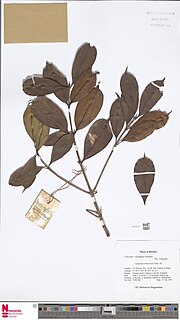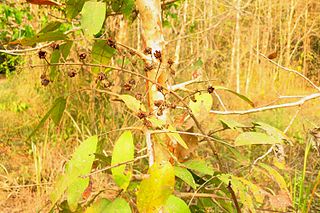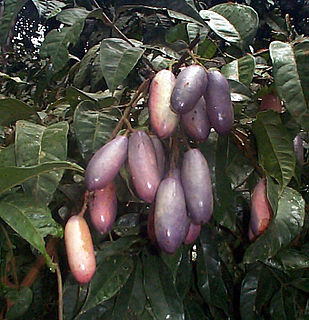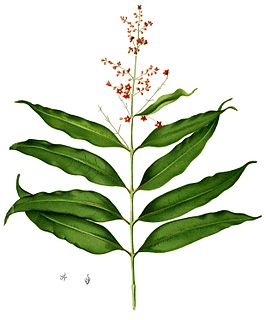
Cratoxylum arborescens is a plant in the family Hypericaceae. The specific epithet arborescens is from the Latin meaning "tree-like".

Cratoxylum cochinchinense is a plant now placed in the family Hypericaceae. The specific epithet cochinchinense is from the Latin meaning "of Cochinchina". In Vietnamese C. cochinchinense is usually called thành ngạch nam or lành ngạnh nam, other names include: hoàng ngưu mộc, hoàng ngưu trà and đỏ ngọn.

Cratoxylum maingayi is a plant in the family Hypericaceae. It is named for the botanist Alexander Carroll Maingay.

Anacolosa is a plant genus of 15 to 22 species in the family Olacaceae. The generic name is from the Greek anakolos, meaning "knotted", referring to the calyx cup rim.

Euthemis is a genus of plant in the family Ochnaceae. The generic name is from the Greek meaning "good law", referring to the even thickness and symmetry of the leaves.
Kibara coriacea is a plant in the family Monimiaceae. The specific epithet coriacea is from the Latin meaning "leathery", referring to the leaves.

Dacryodes is a genus of about 60 species of trees in the family Burseraceae. The generic name is from the Greek dakruon meaning "tear(drop)", referring to how resin droplets form on the bark surface.

Cratoxylum sumatranum is a species of flowering plant in the Hypericaceae family. It is indigenous to Southeast Asia, including Burma, Indochina, Thailand, Malaysia, Sumatra, Java, Lesser Sunda Islands, Borneo, Philippines and Sulawesi.

Ceriops tagal, commonly known as spurred mangrove or Indian mangrove, is a mangrove tree species in the family Rhizophoraceae. It is a protected tree in South Africa. The specific epithet tagal is a plant name from the Tagalog language.
Dictyoneura is a genus of 2–3 species of rainforest trees known to science, constituting part of the plant family Sapindaceae.
Combretocarpus is a monotypic genus of tree in the Anisophylleaceae family. The generic name combretocarpus is from the Greek, referring to the resemblance of its fruit to that of the genus Combretum. As of April 2014 The Plant List recognises the single species Combretocarpus rotundatus.

Dacryodes rostrata is a tree in the family Burseraceae. The specific epithet rostrata is from the Latin meaning "beaked", referring to the narrow-tipped leaves.
Mastixia cuspidata is a tree in the family Nyssaceae. The specific epithet cuspidata is from the Latin meaning "sharp-pointed", referring to the leaf apex.

Cratoxylum glaucum is a plant in the family Hypericaceae. The specific epithet glaucum is from the Latin meaning "blue-green", referring to the colour of the leaf underside.
Anacolosa frutescens, also known as galo or galonut, is a plant in the family Olacaceae. The specific epithet frutescens is from the Latin frutex meaning "shrub". It produces edible fruits and nuts eaten in the Philippines.

Strombosia is a plant genus of about 10 species in the family Olacaceae. It has also been classified in the family Strombosiaceae. The generic name is from the Greek strombos, meaning "pear-shaped", referring to the fruit.

Kandelia is a plant genus of 2 species in the mangrove family Rhizophoraceae.
Gynotroches is a monotypic genus of trees in the family Rhizophoraceae. It contains the single species Gynotroches axillaris. The generic name Gynotroches is from the Greek meaning "woman wheel", referring to the shape of the stigma. The specific epithet axillaris is from the Latin, referring to the axillary position of the flowers.

Gluta velutina is a plant of tropical Asia in the cashew and sumac family Anacardiaceae. The specific epithet velutina is from the Latin meaning "velvety", referring to the inflorescences.
Utania is a genus of flowering plants belonging to the gentian family (Gentianaceae), the tribe Potalieae, and the subtribe Potaliinae. A small genus it has 12 species.














